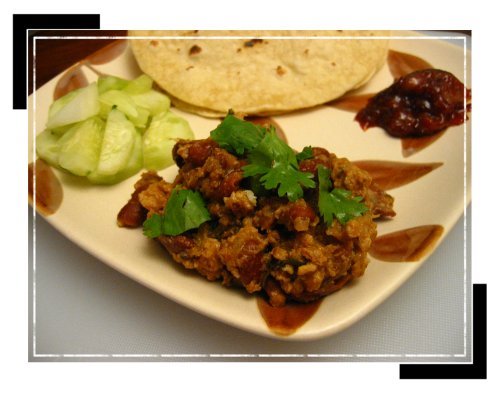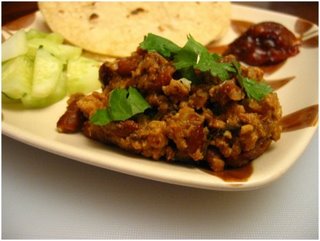
"Give Thanks" said Meeta and I wondered, and wondered...
Should I give Thanks for driving for almost an hour through the drizzle after work only to come home and start dinner when all I want is to be served hot chai while I cuddle up in the couch to watch some "Saas-Bahu" stuff. Should I give Thanks that if I want a hot "chai" I need to make it myself and just forget the pakoris because there's so much left to be done or should I give Thanks because my damned cable does not serve up any "Saas-Bahu" stuff and denies me the pleasure of rotting my mind.
I wondered & muttered and the rain dropped pitter-patter...
And then, my little one jumped all over me, wrapped her arms around me and hugged. I thanked for that, to have her to come home to, to watch her, to love her. And as I mixed the ground chicken, popped open the can of red rajma and chopped up the onions I thanked for being able to do this, to have a family to feed and care for, to have enough food to cook, to take pleasure in what I was doing. And then my husband suggested to adjust the AWB on the camera, set the exposure, and I clicked & he clicked. I thanked for having such a good friend in him who not only ate the rajma I served but was benevolent enough to help me take pictures which looked better than the dish :)
I thanked for being a WOMAN, for having the power to give birth, to work, to feed, to cook, to create & to blog...
Thanks to everyone out there living your life & helping others live theirs. Thanks Meeta for letting me be thankful.
And I went back and cooked my Rajma with Keema. This is not a Bengali dish but I try to make it the way my Ma used to make Keema Mattar which again does not have a Bong stamp to it. But a very hearty meal can be had of this combination, it satisfies with it’s quality & quantity, and there are different ways you can enjoy it.
You can have it with Rice, with Chapati, all by itself with some steamed veggies thrown in, if you make it dry use it as a stuffing for a wrap for lunch next day. I think this is the perfect dish to make if you are rushed and want to make something for dinner, next day lunch and a different dinner out of it on day 2.

What You Need
Rajma or Red Kidney Beans ~ 1 can, it said 1lb 13oz. I used this from Goya. If you are not using canned you might have to go through the process of soaking & pressure cooking the rajma.
Ground Chicken (Keema) ~ 1 lb. I used this from Perdue Ground Chicken. You can use fresh if you get them.
Onions ~ 2 medium grind to paste
Tomato ~ 2 medium blended (chopped does no harm either)
Green Chillies ~ 5/6 chopped
Corriander leaves ~ for garnish
For Marinating the Chicken:
Ginger Paste ~ 2 tsp for marinade
Garlic Paste ~ 2 tsp for marinade
Yogurt ~ 2 -3 tbsp
For Masala:
Garlic Clove ~ 1 clove chopped
Elaichi or Cardamom ~ 5
Laung or Cloves ~ 5
Darchini or Cinnamon stick ~ a small one
Maggi Hot & Sweet Tomato Ketchup ~ my all time fav or any other tangy sauce
Jeera or Cumin Powder ~ 1 tsp
Dhania or Corriander Powder ~ 1tsp
I dry roast Cumin seeds, Dhania Seeds, Dried Red Chillies and then dry grind them and store that for this and many other cooking. You can do that when you have time.
Garam masala Powder ~ I make this and store it too, but whatever you have is fine
Red Chilli Powder ~ your choice
Salt
How I Do It
Marinade the ground chicken with yogurt, 2 tsp of ginger paste, 2 tsp of garlic paste and little salt. Keep it aside for 2-3 hours. I often do it night before so it’s just ready to be cooked by evening.
Make a paste of the onions. Quick Tip: I make a paste or chop onions when I have extra time. They stay in the fridge good for 3/4 days
Heat Oil in a Kadai /Frying Pan
Coarsely pound the Elaichi (Cardamom), Laung (Cloves) & Darchini (Cinnamon Sticks) and add it to the oil
Add the chopped garlic and the green chillies.
As soon as you get the fragrant smell of garlic rising add the onions.
Add a little sugar and fry them till they are light brown in color.
Add the tomato
Continue light frying till oil separetes from the paste.
Add the marinated Keema (ground Chicken)
Continue cooking till the Keema changes color. Stir so that the keema transforms to a granulated mass. Since ground chicken here is machine processed, when raw, they are like a soft paste.
Add the Cumin, Corriander & Red Chilli Powder. Mix well.
Add about 2 tbsp of the Maggi Sauce (or any other). Actually I didn’t measure, I just poured till I got the tangy taste & color.
Add the Rajma .
Cook for some more time till the masala engulfs the Rajma as well as the Keema
Add little water, salt, Garam masala Powder and cover and Cook
Cook till Rajma is done. The Rajma I cook is not gravy based, it’s on the dry side, if you want gravy go ahead.
Add a little Fajita Seasoning Mix or KitchenKing Masala if you feel the taste is lacking something. I do that.
Garnish with Corriander leaves.
If you want add chopped hard boiled eggs.
 Enjoy hot spicy Rajma Keema any way you like.
Enjoy hot spicy Rajma Keema any way you like.Let me reiterate, I kind of cook by smell & taste & instinct so my measures stated might not be exact, feel free to innovate & deviate. I am trying to measure while cooking these days but on a busy day, nah-nah !!
This is my entry for Monthly Mingle at photographer cook Meeta's of What's For Lunch Honey. Her very interesting theme was Give Thanks. And as I eat my dinner I do just that.
Happy ThanksGiving.
Note: For Vegans out there, instead of using keema you can substitute keema with ground soy granules as in Egg paratha with twist
Trivia:Red beans and rice is an emblematic dish of Louisiana Creole cuisine (not originally of Cajun cuisine), traditionally made on Mondays with red beans, vegetables (onion and celery), spices (thyme, cayenne pepper, and bay leaf), and pork bones left over from Sunday dinner, cooked together slowly in a pot and served over rice. From Wiki.









